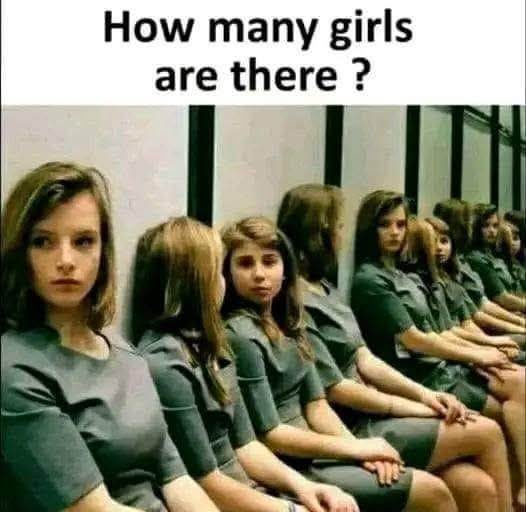Optical illusions have a way of playing tricks on our minds, making us question what we see. One such illusion making waves online is an image that appears to show multiple girls sitting in a row. At first glance, it seems like a group of friends posing together, but a closer look reveals something much more fascinating—a clever mirror trick creating an illusion of more people than actually exist.
So, how many girls are really in the picture? Let’s break it down with a detailed visual illusion analysis and uncover the truth behind this intriguing image.

The Optical Illusion Explained: Why Our Eyes Deceive Us
Our brains are wired to recognize patterns, faces, and symmetry, which is why mirrors can trick us so easily. When we see multiple reflections arranged in a way that looks natural, our minds assume there are more people present than there actually are.
In this image, a large mirror behind the girls is responsible for creating duplicate reflections, making it appear as though there are more individuals in the frame. The reflections are so perfectly aligned that it’s hard to tell where reality ends and illusion begins.
Video: How Many Girls Do You See?
The Role of the Mirror: A Key Element in the Trick
The key to unraveling this illusion lies in understanding how the mirror interacts with the real subjects in the image. Here’s how it works:
- A large mirror is placed behind the girls, reflecting their images multiple times.
- The reflections are seamless, giving the impression of a continuous row of people.
- Lighting and positioning play a crucial role in making the illusion believable, as there are no harsh breaks in the reflections.
Without paying close attention, our brains quickly assume that each reflection is a separate person, creating a misleading sense of crowding in the image.
Identifying the Real Girls: How Many Are Actually There?
To determine the real number of people in the image, we need to look for clues that differentiate real figures from reflections. The best way to do this is by examining physical details that aren’t duplicated by the mirror.
Key Observations to Spot the Real People:
✔ Shoulders and Posture:
- Real individuals will have their shoulders and upper bodies fully visible.
- Reflections, on the other hand, may appear slightly cut off or aligned too perfectly.
✔ Hair and Unique Features:
- Hairlines, parting, and hair placement are key indicators of real versus reflected images.
- If all the “girls” have identical hairstyles in perfect alignment, it’s likely an illusion.
✔ Leg Positioning and Shadows:
- The legs of real individuals will cast shadows or have slight variations in angles.
- Mirror reflections will mimic the exact same stance, reinforcing the illusion.
After a detailed analysis using these methods, the reality becomes clear—there are only 2 real girls in the image. The rest are simply reflections, creating a deceptive illusion of a larger group.
Video: How many girls are there?? 🧠🤔#shorts #ytshorts #riddles #puzzle
Why Do We Fall for This Illusion? The Science Behind It
Our brains are wired for efficiency, meaning we process visual information as quickly as possible to make sense of our surroundings. This is why optical illusions work—they exploit how our minds interpret images.
Three Main Factors Behind the Illusion:
1️⃣ Symmetry and Alignment – When objects are reflected symmetrically, our brains register them as separate entities instead of duplicates.
2️⃣ Context and Expectation – We’re accustomed to seeing groups of people sitting together, so our brains naturally assume there are more individuals than there actually are.
3️⃣ Lack of a Visual Break – If a mirror’s edge is hidden and the lighting is balanced, reflections blend seamlessly into the background, reinforcing the illusion.
This combination of psychology and perception is what makes the image so tricky to decipher at first glance.
Other Optical Illusions That Trick the Eye
If you enjoyed analyzing this illusion, here are a few other famous visual tricks that have left people scratching their heads:
🔹 The Dress Debate (Blue & Black or White & Gold?) – An image where people saw two different color schemes, proving how lighting can alter perception.
🔹 The Spinning Dancer Illusion – A silhouette that appears to spin in both directions, depending on how your brain interprets it.
🔹 Escher’s Staircase – A drawing where staircases seem to loop infinitely, playing on our brain’s understanding of depth and dimension.
Just like these famous illusions, the “How Many Girls” image is a perfect example of how perception can be easily distorted.
Final Conclusion: The Truth Behind the Illusion
After careful analysis, the final answer is clear—there are only 2 real girls in the picture. Everything else is a result of cleverly placed mirrors and perfect reflections, tricking the eye into seeing a much larger group than what actually exists.
This optical illusion reminds us that our eyes don’t always tell the whole truth. Sometimes, we need to look beyond the obvious to uncover reality. Whether it’s an illusion in photography, an artistic masterpiece, or a trick of the light, our perception of the world is often shaped by what our brains expect to see.